2013 MERCEDES-BENZ GLK-CLASS SUV light
[x] Cancel search: lightPage 265 of 380
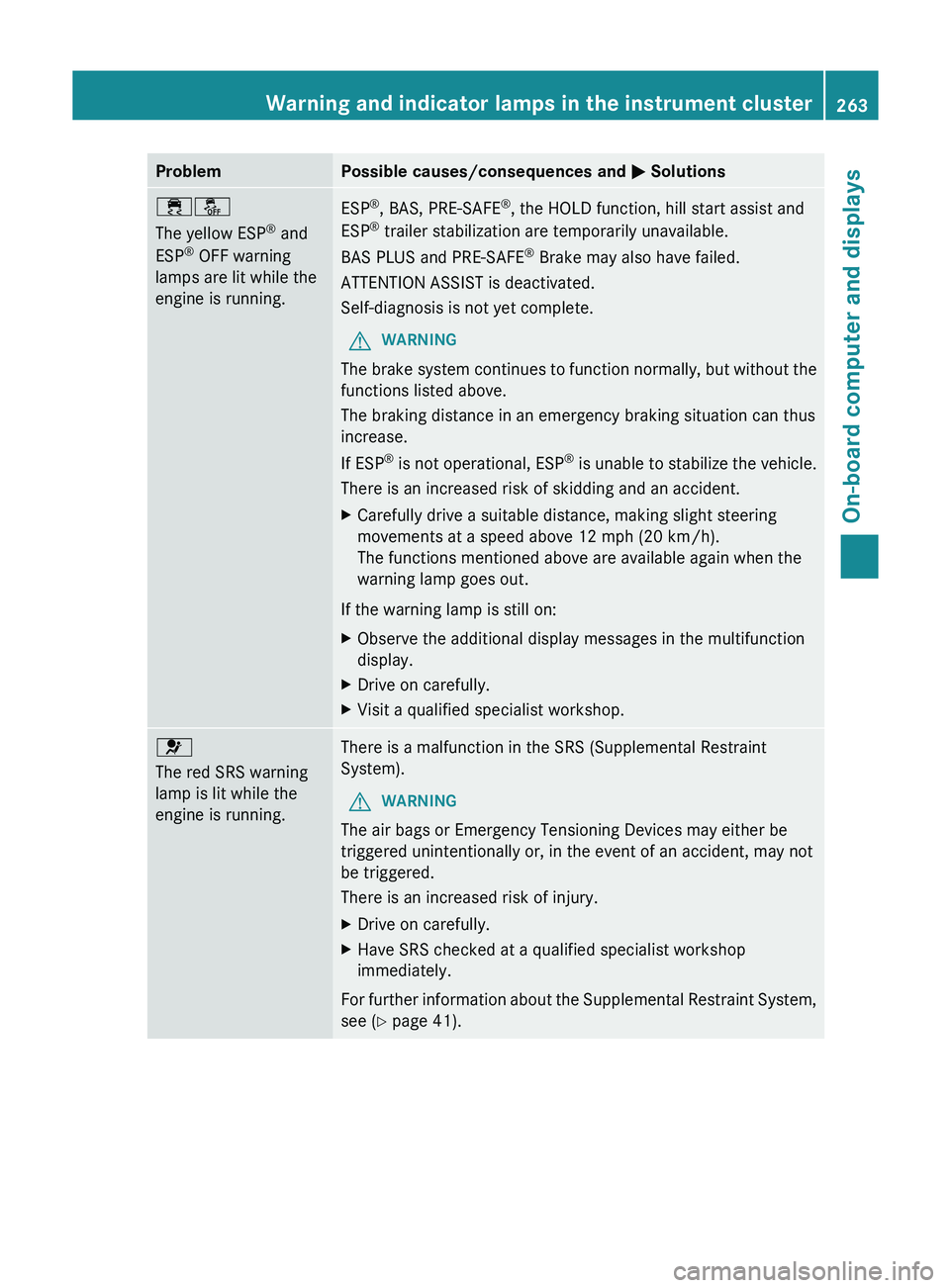
Problem Possible causes/consequences and
0050 Solutions00E500BB
The yellow ESP
®
and
ESP ®
OFF warning
lamps are lit while the
engine is running. ESP
®
, BAS, PRE-SAFE ®
, the HOLD function, hill start assist and
ESP ®
trailer stabilization are temporarily unavailable.
BAS PLUS and PRE-SAFE ®
Brake may also have failed.
ATTENTION ASSIST is deactivated.
Self-diagnosis is not yet complete.
G WARNING
The brake system continues to function normally, but without the
functions listed above.
The braking distance in an emergency braking situation can thus
increase.
If ESP ®
is not operational, ESP®
is unable to stabilize the vehicle.
There is an increased risk of skidding and an accident.
X Carefully drive a suitable distance, making slight steering
movements at a speed above 12 mph (20 km/h).
The functions mentioned above are available again when the
warning lamp goes out.
If the warning lamp is still on:
X Observe the additional display messages in the multifunction
display.
X Drive on carefully.
X Visit a qualified specialist workshop. 0075
The red SRS warning
lamp is lit while the
engine is running.
There is a malfunction in the SRS (Supplemental Restraint
System).
G WARNING
The air bags or Emergency Tensioning Devices may either be
triggered unintentionally or, in the event of an accident, may not
be triggered.
There is an increased risk of injury.
X Drive on carefully.
X Have SRS checked at a qualified specialist workshop
immediately.
For further information about the Supplemental Restraint System,
see ( Y page 41). Warning and indicator lamps in the instrument cluster
263
On-board computer and displays Z
Page 266 of 380
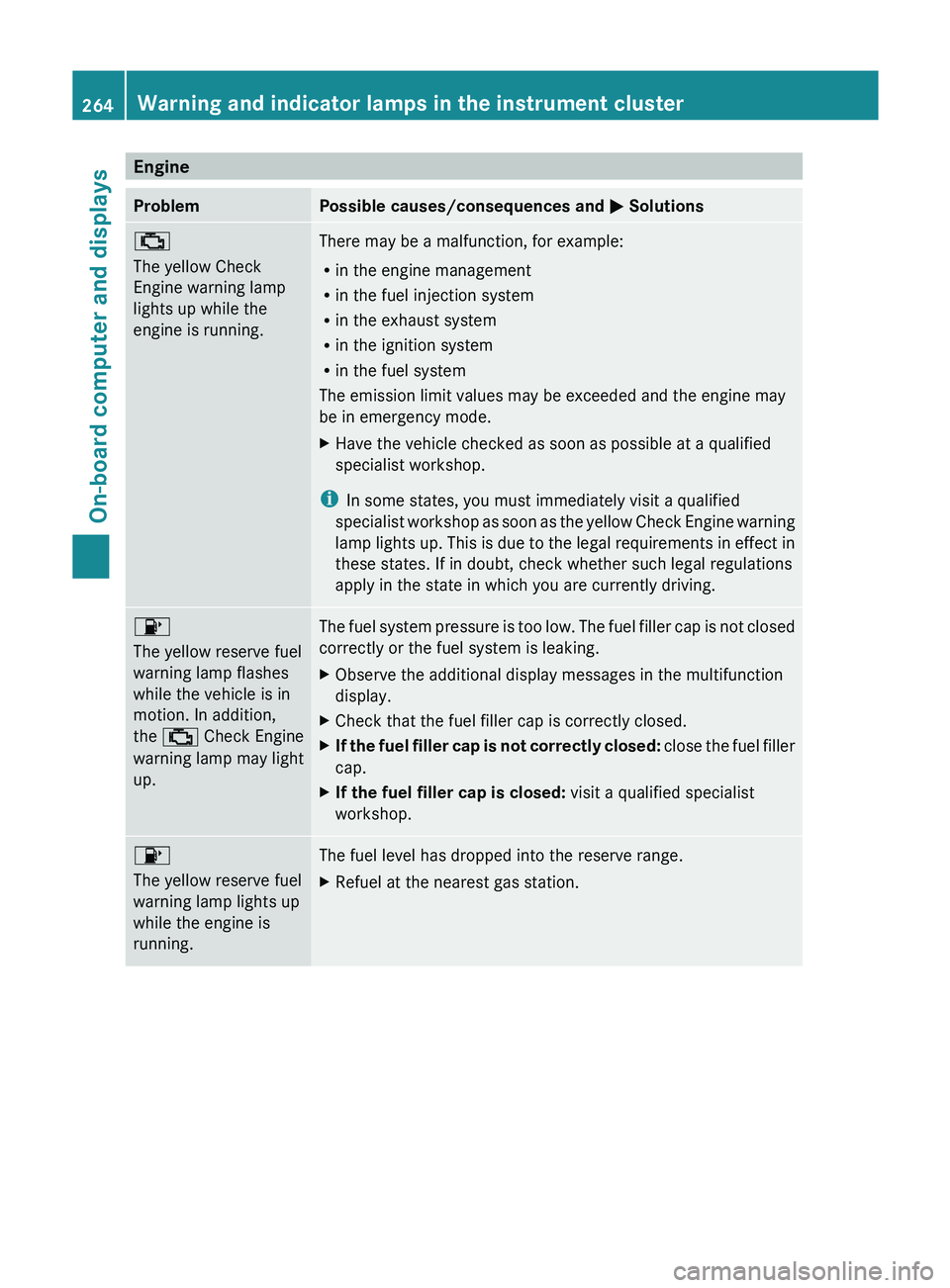
Engine
Problem Possible causes/consequences and
0050 Solutions00B9
The yellow Check
Engine warning lamp
lights up while the
engine is running.
There may be a malfunction, for example:
R
in the engine management
R in the fuel injection system
R in the exhaust system
R in the ignition system
R in the fuel system
The emission limit values may be exceeded and the engine may
be in emergency mode.
X Have the vehicle checked as soon as possible at a qualified
specialist workshop.
i In some states, you must immediately visit a qualified
specialist workshop as soon as
the yellow Check Engine warning
lamp lights up. This is due to the legal requirements in effect in
these states. If in doubt, check whether such legal regulations
apply in the state in which you are currently driving. 00B6
The yellow reserve fuel
warning lamp flashes
while the vehicle is in
motion. In addition,
the
00B9 Check Engine
warning lamp may light
up. The fuel system pressure is too low. The fuel filler cap is not closed
correctly or the fuel system is leaking.
X
Observe the additional display messages in the multifunction
display.
X Check that the fuel filler cap is correctly closed.
X If the fuel filler cap is not correctly closed:
close the
fuel filler
cap.
X If the fuel filler cap is closed: visit a qualified specialist
workshop. 00B6
The yellow reserve fuel
warning lamp lights up
while the engine is
running.
The fuel level has dropped into the reserve range.
X
Refuel at the nearest gas station.264
Warning and indicator lamps in the instrument clusterOn-board computer and displays
Page 267 of 380

Problem Possible causes/consequences and
0050 Solutions00AC
The red coolant
warning lamp lights up
while the engine is
running and the coolant
temperature gauge is
at
the
start of the scale. The temperature sensor for the coolant temperature gauge is
defective.
The
coolant temperature
is no
longer being monitored. There is a
risk of engine damage if the coolant temperature is too high.
X Pull over and stop the vehicle safely and switch off the engine,
paying attention to road and
traffic conditions. Do not continue
driving under any circumstances.
X Secure the vehicle against rolling away ( Y page 160).
X Consult a qualified specialist workshop. Warning and indicator lamps in the instrument cluster
265
On-board computer and displays Z
Page 269 of 380
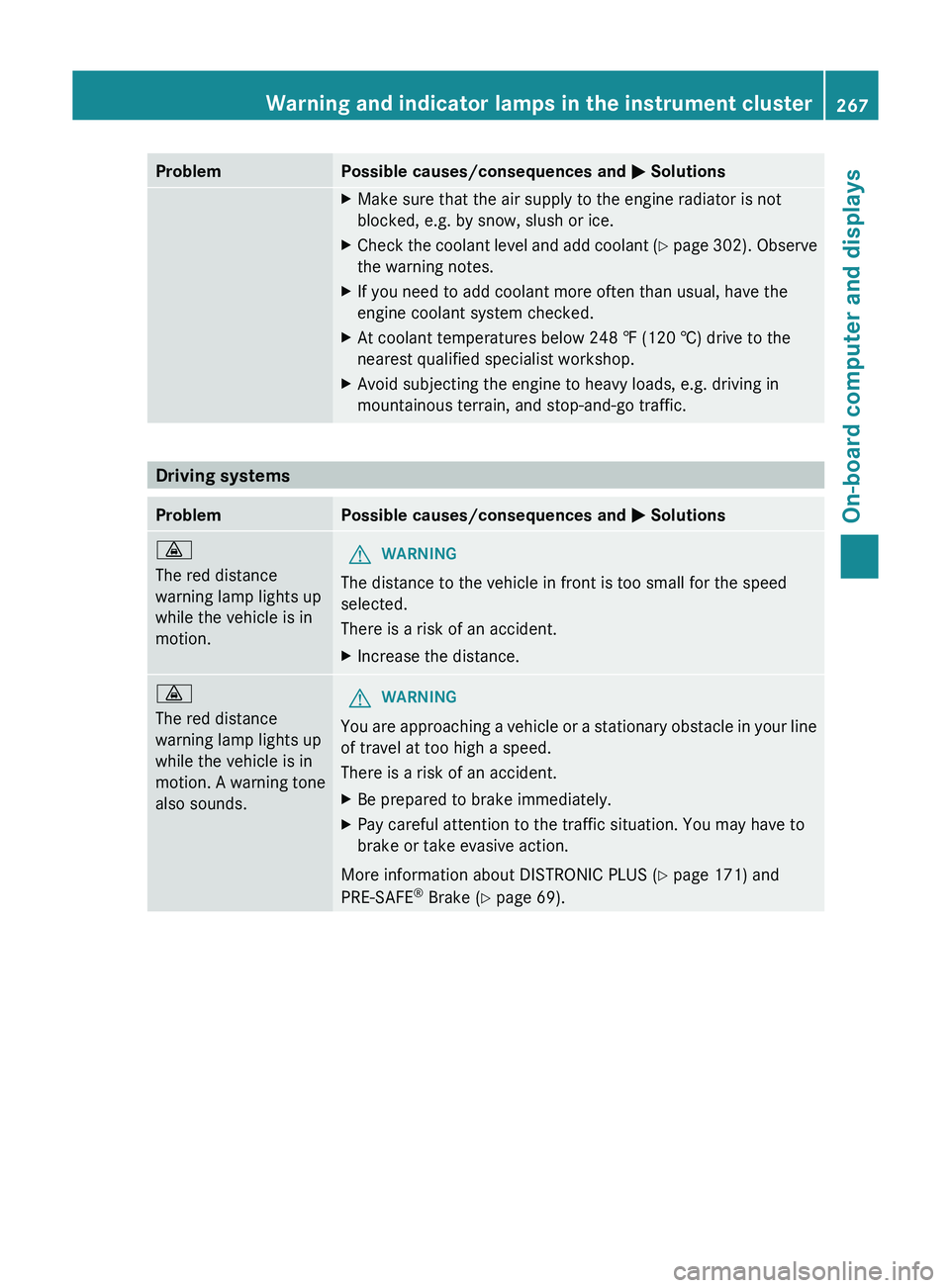
Problem Possible causes/consequences and
0050 SolutionsX
Make sure that the air supply to the engine radiator is not
blocked, e.g. by snow, slush or ice.
X Check the coolant level and add coolant (Y page 302). Observe
the warning notes.
X If you need to add coolant more often than usual, have the
engine coolant system checked.
X At coolant temperatures below 248 ‡ (120 †) drive to the
nearest qualified specialist workshop.
X Avoid subjecting the engine to heavy loads, e.g. driving in
mountainous terrain, and stop-and-go traffic. Driving systems
Problem Possible causes/consequences and
0050 Solutions00BA
The red distance
warning lamp lights up
while the vehicle is in
motion.
G
WARNING
The distance to the vehicle in front is too small for the speed
selected.
There is a risk of an accident.
X Increase the distance. 00BA
The red distance
warning lamp lights up
while the vehicle is in
motion. A warning tone
also sounds. G
WARNING
You are approaching a vehicle or a stationary obstacle in your line
of travel at too high a speed.
There is a risk of an accident.
X Be prepared to brake immediately.
X Pay careful attention to the traffic situation. You may have to
brake or take evasive action.
More information about DISTRONIC PLUS (Y page 171) and
PRE-SAFE ®
Brake (Y page 69). Warning and indicator lamps in the instrument cluster
267On-board computer and displays Z
Page 275 of 380
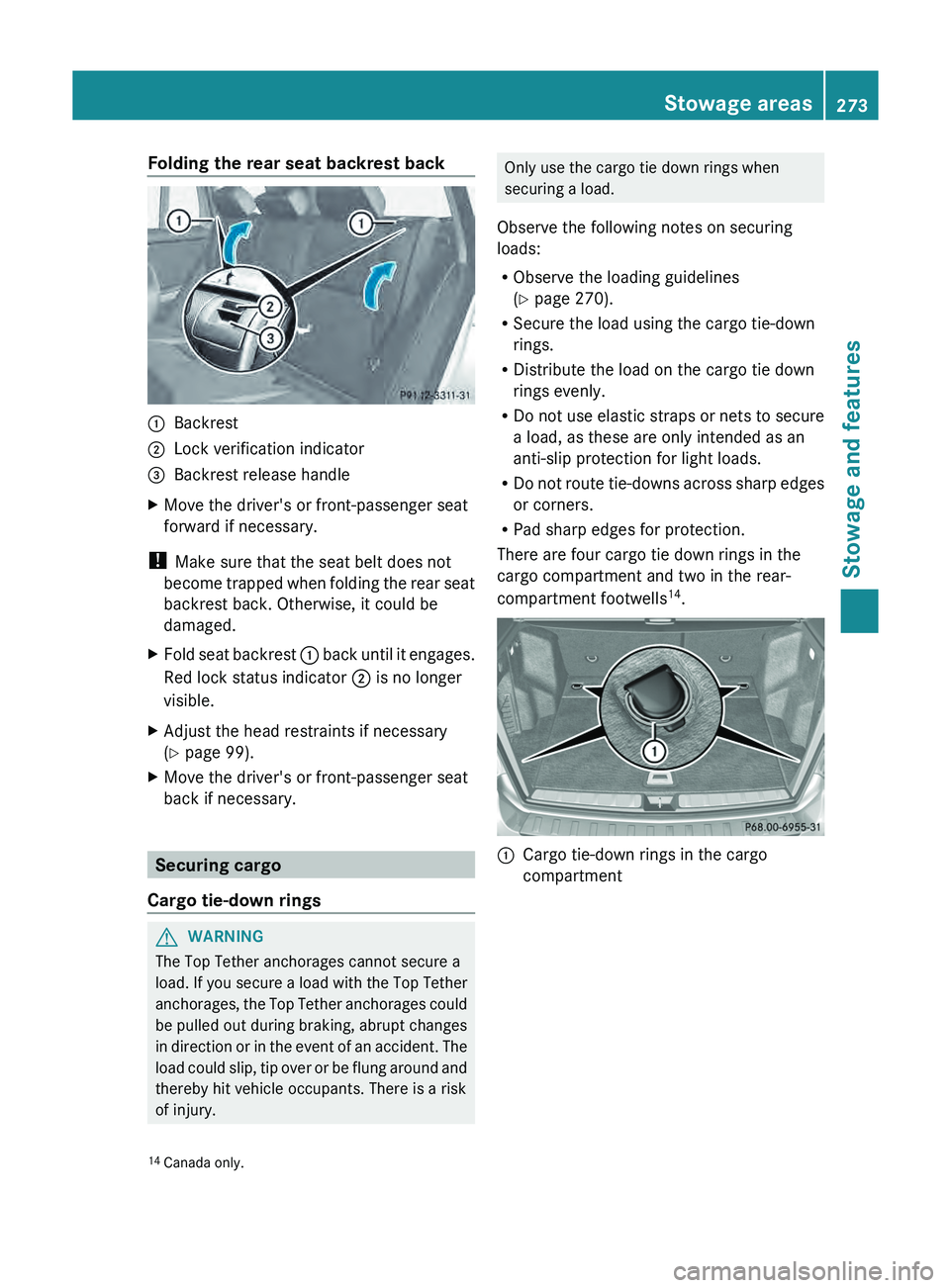
Folding the rear seat backrest back
0043
Backrest
0044 Lock verification indicator
0087 Backrest release handle
X Move the driver's or front-passenger seat
forward if necessary.
! Make sure that the seat belt does not
become trapped when folding
the
rear seat
backrest back. Otherwise, it could be
damaged.
X Fold seat backrest 0043 back until it engages.
Red lock status indicator
0044 is no longer
visible.
X Adjust the head restraints if necessary
(Y page 99).
X Move the driver's or front-passenger seat
back if necessary. Securing cargo
Cargo tie-down rings G
WARNING
The Top Tether anchorages cannot secure a
load. If you secure a
load with the Top Tether
anchorages, the Top Tether anchorages could
be pulled out during braking, abrupt changes
in direction or in the event of an accident. The
load could slip, tip over or be flung around and
thereby hit vehicle occupants. There is a risk
of injury. Only use the cargo tie down rings when
securing a load.
Observe the following notes on securing
loads:
R Observe the loading guidelines
(Y page 270).
R Secure the load using the cargo tie-down
rings.
R Distribute the load on the cargo tie down
rings evenly.
R Do not use elastic straps
or nets to secure
a load, as these are only intended as an
anti-slip protection for light loads.
R Do not route tie-downs across sharp edges
or corners.
R Pad sharp edges for protection.
There are four cargo tie down rings in the
cargo compartment and two in the rear-
compartment footwells 14
. 0043
Cargo tie-down rings in the cargo
compartment
14 Canada only. Stowage areas
273
Stowage and features Z
Page 276 of 380
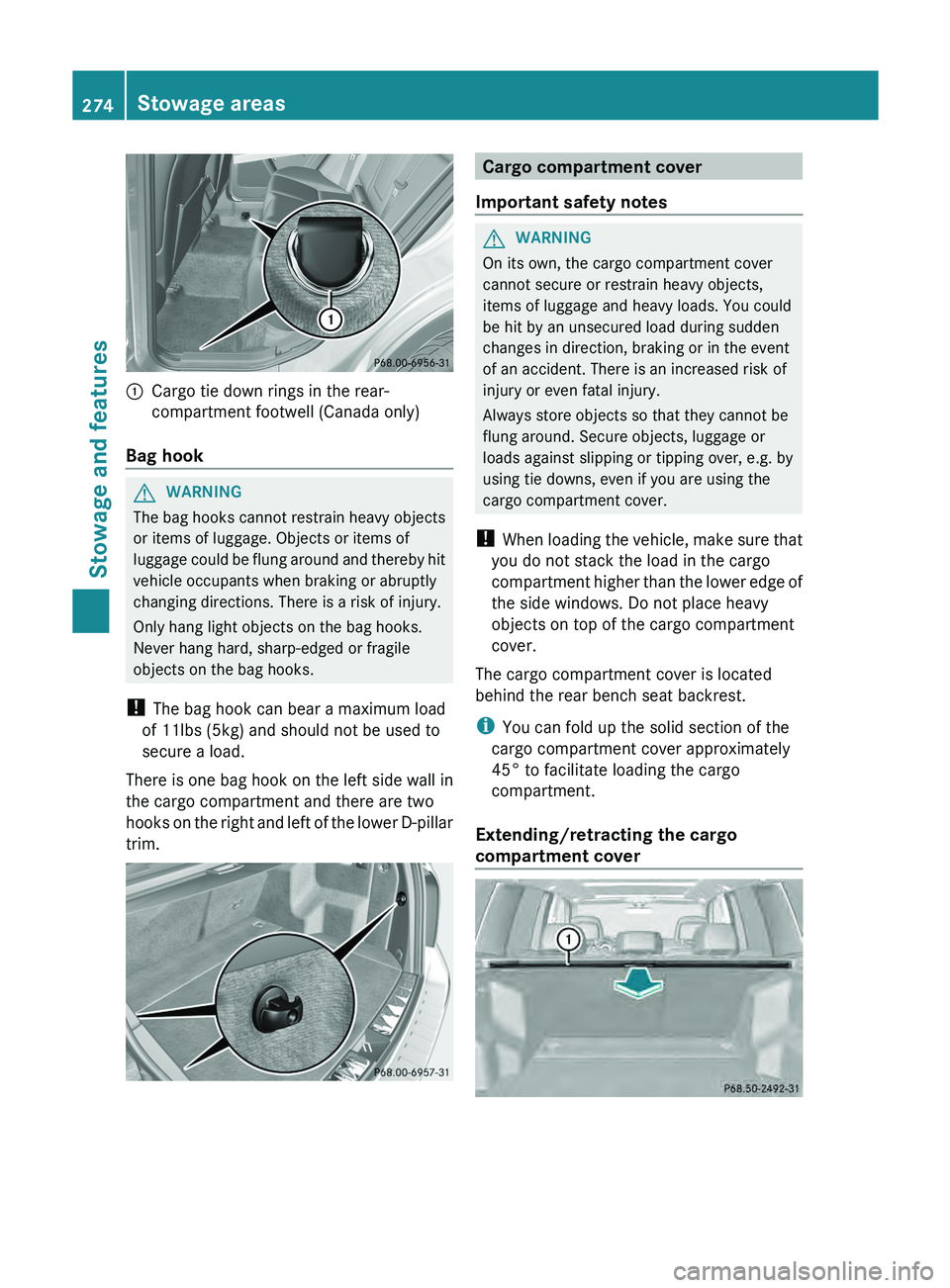
0043
Cargo tie down rings in the rear-
compartment footwell (Canada only)
Bag hook G
WARNING
The bag hooks cannot restrain heavy objects
or items of luggage. Objects or items of
luggage could be flung around
and thereby hit
vehicle occupants when braking or abruptly
changing directions. There is a risk of injury.
Only hang light objects on the bag hooks.
Never hang hard, sharp-edged or fragile
objects on the bag hooks.
! The bag hook can bear a maximum load
of 11lbs (5kg) and should not be used to
secure a load.
There is one bag hook on the left side wall in
the cargo compartment and there are two
hooks on the right and left of the lower D-pillar
trim. Cargo compartment cover
Important safety notes G
WARNING
On its own, the cargo compartment cover
cannot secure or restrain heavy objects,
items of luggage and heavy loads. You could
be hit by an unsecured load during sudden
changes in direction, braking or in the event
of an accident. There is an increased risk of
injury or even fatal injury.
Always store objects so that they cannot be
flung around. Secure objects, luggage or
loads against slipping or tipping over, e.g. by
using tie downs, even if you are using the
cargo compartment cover.
! When loading the vehicle, make
sure that
you do not stack the load in the cargo
compartment higher than the lower edge of
the side windows. Do not place heavy
objects on top of the cargo compartment
cover.
The cargo compartment cover is located
behind the rear bench seat backrest.
i You can fold up the solid section of the
cargo compartment cover approximately
45° to facilitate loading the cargo
compartment.
Extending/retracting the cargo
compartment cover 274
Stowage areas
Stowage and features
Page 279 of 380
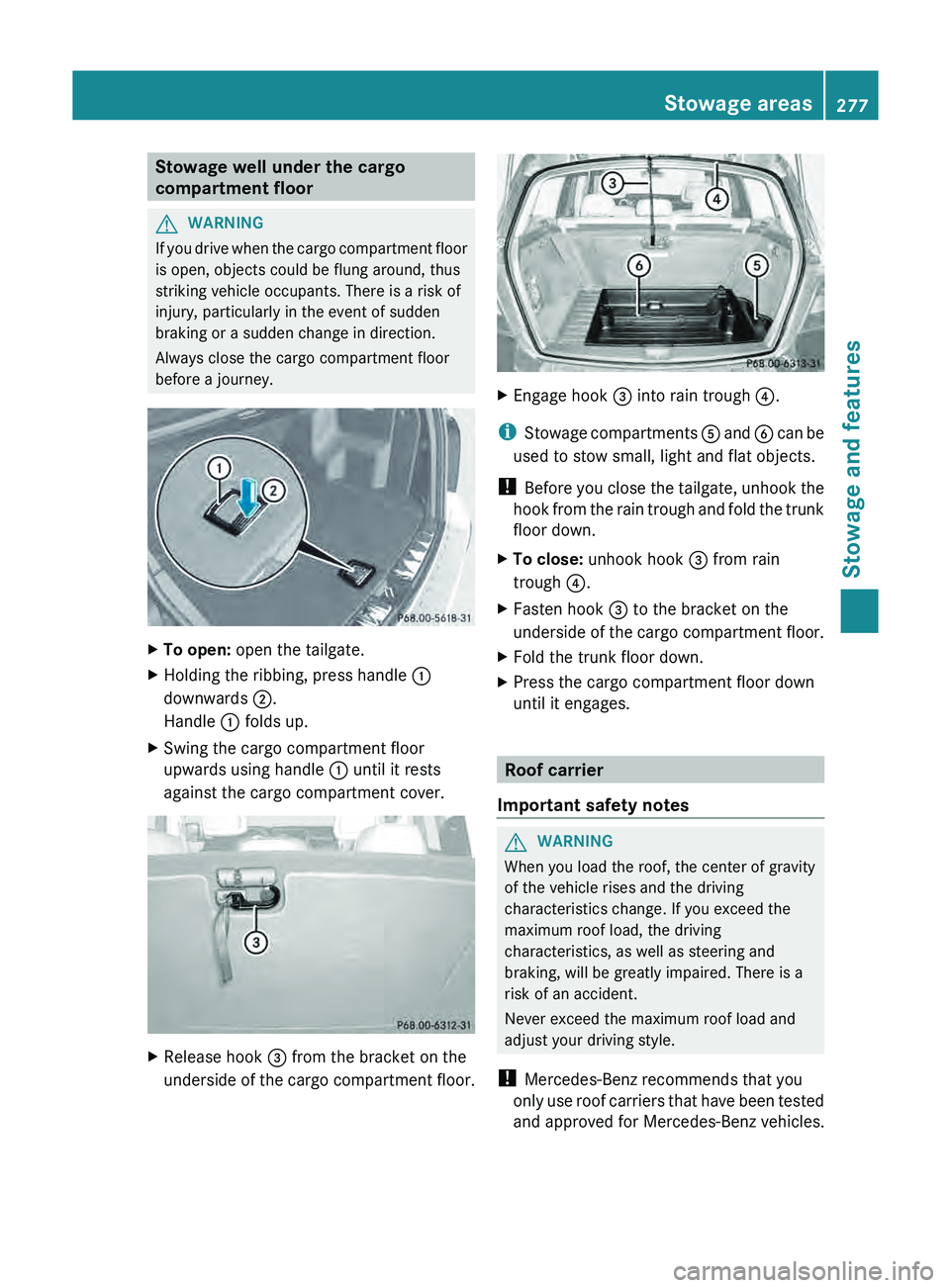
Stowage well under the cargo
compartment floor
G
WARNING
If you drive when the cargo compartment floor
is open, objects could be flung around, thus
striking vehicle occupants. There is a risk of
injury, particularly in the event of sudden
braking or a sudden change in direction.
Always close the cargo compartment floor
before a journey. X
To open: open the tailgate.
X Holding the ribbing, press handle 0043
downwards 0044.
Handle 0043 folds up.
X Swing the cargo compartment floor
upwards using handle 0043 until it rests
against the cargo compartment cover. X
Release hook 0087 from the bracket on the
underside of the cargo compartment
floor. X
Engage hook 0087 into rain trough 0085.
i Stowage compartments 0083 and 0084
can be
used to stow small, light and flat objects.
! Before you close the tailgate, unhook the
hook from the rain trough and fold the trunk
floor down.
X To close: unhook hook 0087 from rain
trough 0085.
X Fasten hook 0087 to the bracket on the
underside of the cargo compartment
floor.
X Fold the trunk floor down.
X Press the cargo compartment floor down
until it engages. Roof carrier
Important safety notes G
WARNING
When you load the roof, the center of gravity
of the vehicle rises and the driving
characteristics change. If you exceed the
maximum roof load, the driving
characteristics, as well as steering and
braking, will be greatly impaired. There is a
risk of an accident.
Never exceed the maximum roof load and
adjust your driving style.
! Mercedes-Benz recommends that you
only use roof
carriers that
have been tested
and approved for Mercedes-Benz vehicles. Stowage areas
277
Stowage and features Z
Page 280 of 380
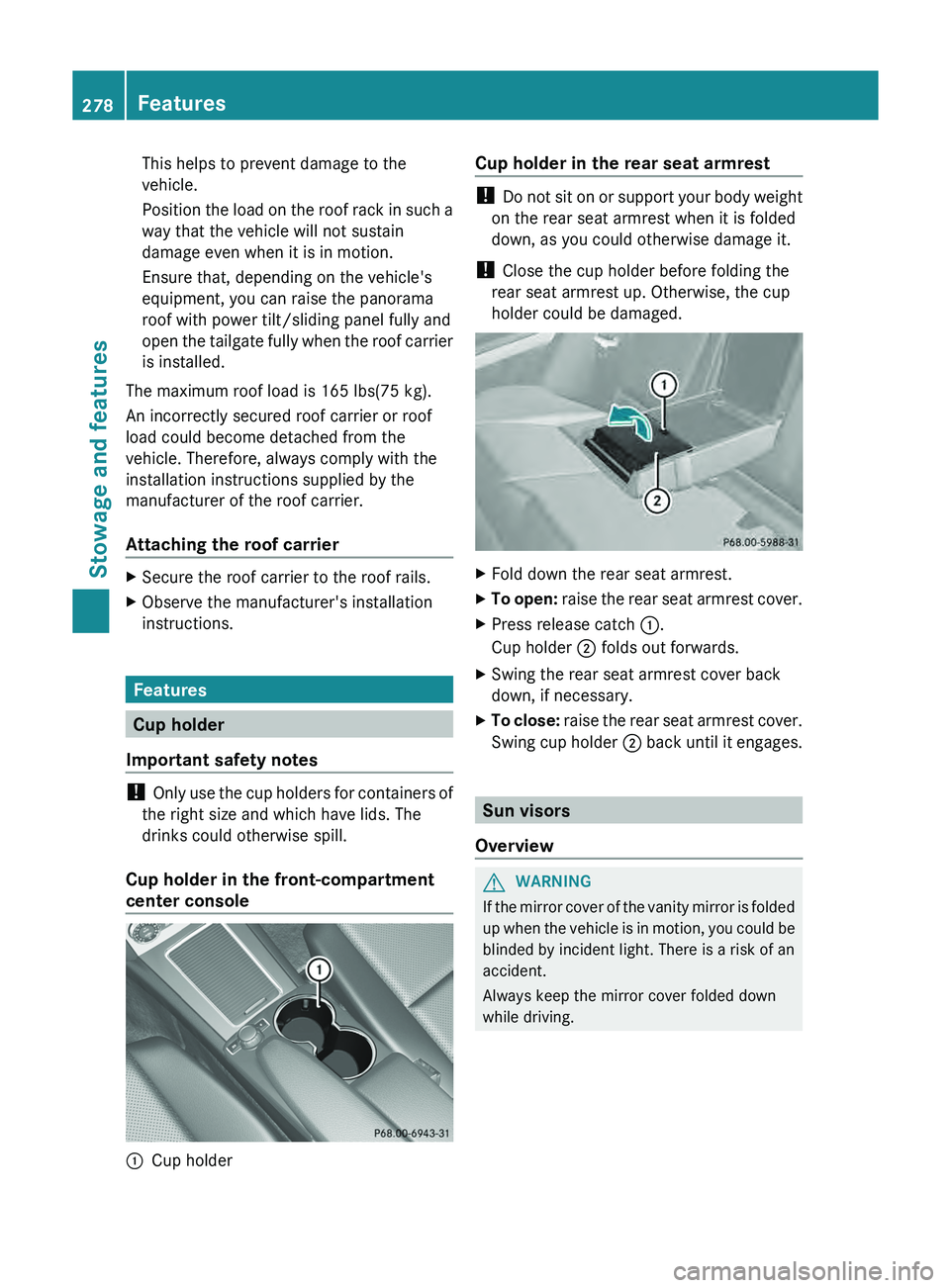
This helps to prevent damage to the
vehicle.
Position the load on
the
roof rack in such a
way that the vehicle will not sustain
damage even when it is in motion.
Ensure that, depending on the vehicle's
equipment, you can raise the panorama
roof with power tilt/sliding panel fully and
open the tailgate fully when the roof carrier
is installed.
The maximum roof load is 165 lbs(75 kg).
An incorrectly secured roof carrier or roof
load could become detached from the
vehicle. Therefore, always comply with the
installation instructions supplied by the
manufacturer of the roof carrier.
Attaching the roof carrier X
Secure the roof carrier to the roof rails.
X Observe the manufacturer's installation
instructions. Features
Cup holder
Important safety notes !
Only use the cup holders
for containers of
the right size and which have lids. The
drinks could otherwise spill.
Cup holder in the front-compartment
center console 0043
Cup holder Cup holder in the rear seat armrest !
Do not sit on or
support your body weight
on the rear seat armrest when it is folded
down, as you could otherwise damage it.
! Close the cup holder before folding the
rear seat armrest up. Otherwise, the cup
holder could be damaged. X
Fold down the rear seat armrest.
X To open: raise the rear seat armrest cover.
X Press release catch 0043.
Cup holder 0044 folds out forwards.
X Swing the rear seat armrest cover back
down, if necessary.
X To close:
raise the rear seat armrest cover.
Swing cup holder 0044
back until it engages. Sun visors
Overview G
WARNING
If the mirror cover of the vanity mirror is folded
up when the vehicle is
in motion, you could be
blinded by incident light. There is a risk of an
accident.
Always keep the mirror cover folded down
while driving. 278
Features
Stowage and features